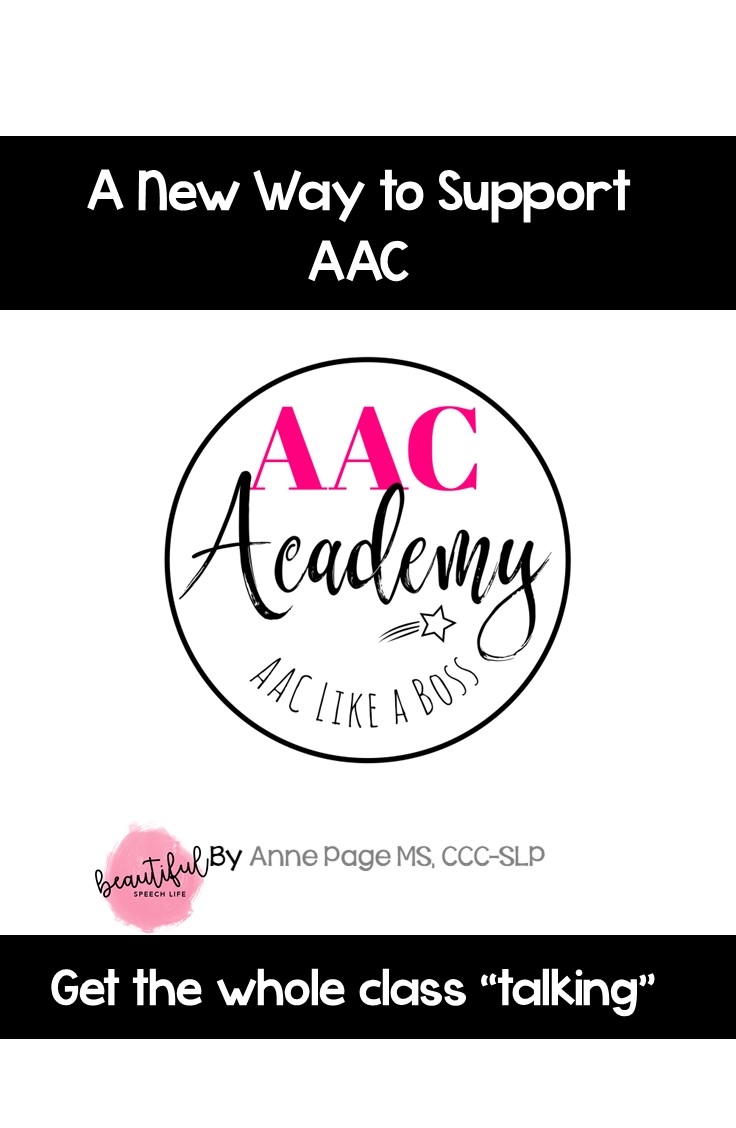
by Anne Page | Oct 18, 2016 | SLP Like a Boss, SLP Time Hacks, The Organized SLP, Uncategorized
Today I’m welcoming my colleagues (and friends) Sarah and Lisa from SLP Toolkit, to share with you how they quickly and efficiently gather data for a transfer student. You know…the one that shows up with an IEP that expires in three days. It’s happened to all of us right?[spacer height=”20px”]
Just for a little background info, SLP Toolkit is a web based software program that was created by two speech language pathologists. Lisa Kathman and Sarah Bevier. I’ll provide some links at the end of this post so you can learn more. Let’s jump right in and see what they suggest.[spacer height=”20px”]

The transfer student is the bane of every school-based SLP’s existence. The student pops onto your caseload, often with an IEP that is expired or soon to expire, with about 12 goals that you have no idea how the previous SLP even measured.[spacer height=”20px”]
So what if that is the case? The IEP is due immediately and you don’t know the student. The school year is in full swing and you are way beyond the start of the year “getting to know you” activities. How do you get the data you need to write a new IEP for a student you just met?[spacer height=”20px”]
Well, if you have SLP Toolkit in your arsenal, there’s no need to panic! First, you add the student to your caseload and open up a Present Level Assessment (PLA). As a new student, giving all components of the PLA will provide you with a really comprehensive communication profile. These assessments contain both descriptive language (e.g. language sample, narrative or expository retell) and specific skill based (e.g. vocabulary, answering questions, grammar, problem solving) measures. The software scores everything for you, noting areas of strength and need, as well as provides an auto-summary of results that can be copy and pasted into the present levels section of the student’s IEP. [spacer height=”20px”]
With a comprehensive present levels section, the rest of the IEP writes itself since your goals and service time are driven by this information. You can probe areas of weakness further using criterion referenced tests in the ‘Progress Monitoring’ section of SLP Toolkit. Criterion referenced tests measure the student’s performance against a fixed set of predetermined criteria. You will use this information as baseline scores on your IEP goals and then re-test at each grading period using the same measures. To ensure you are writing measurable goals that unfamiliar readers can understand, the SMART goal drop downs in the ‘Goals’ section of SLP Toolkit makes writing an objective, measurable goal a breeze. If any of the students needs can be met through accommodations versus goals (or if these are needed in addition to specialized instruction), you can browse a wide variety of options in the ‘Teacher Strategies/Accommodations’ section of SLP Toolkit.[spacer height=”20px”]
Once your goals are created inside of SLP Toolkit, you can hit the “print” button to access pre-populated data sheets (one less thing to create for this new student!)[spacer height=”20px”]
Transfer students only cause panic if you don’t know what to do with them. With SLP Toolkit on your side, you have a step by step guide to ensure you can develop and carry out a comprehensive treatment plan for any new student on your caseload.[spacer height=”20px”]
Lisa & Sarah, SLP Toolkit[spacer height=”20px”]
One of the most used tools in my bag of tricks! SLP Toolkit has saved me HOURS of work. Now I can easily assess present levels and give accurate, helpful progress reports. And the goal bank to die for. I know and trust this awesome resource so much that I’ve teamed up with SLP Toolkit to provide you this code.Use my code BSL16 and you’ll receive:
$19 to apply to either one free month or towards an annual membership. Just click on the pink rectangle to learn more and sign up. Remember the code is BSL16 for your special discount.

This link is an affiliate link, which means, if you choose to purchase through this link, I’ll earn a commission. This commission comes at no additional cost to you.. Please understand that I have experience with this company and I recommend it because it’s helpful and useful, not because of the small commission I make if you decide to purchase.
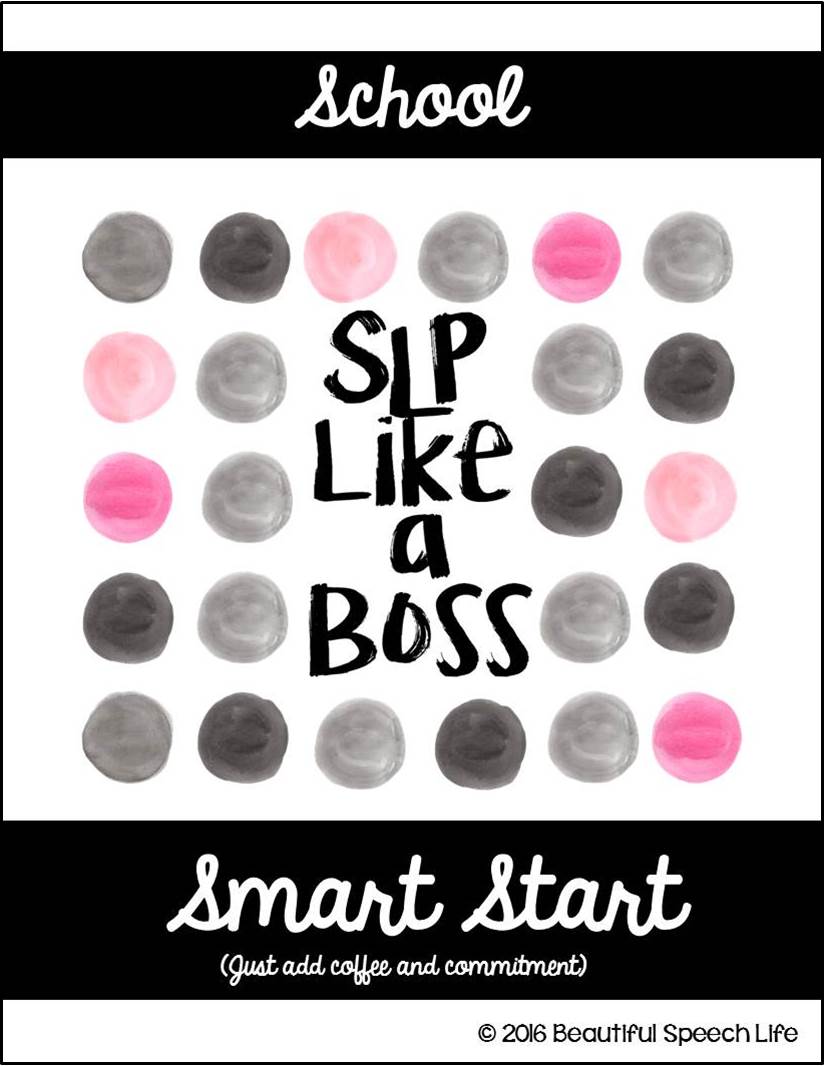
by Anne Page | Aug 21, 2016 | Freebies, SLP Like a Boss, SLP Time Hacks
Two weeks into the school year and already feeling a tiny bit overwhelmed?[spacer height=”10px” id=”2″]
It happens! With IEPs, evaluations, scheduling, team building and oh yeah, THERAPY, you’re probably wishing there were more hours in a day. Believe me, I’ve been there.[spacer height=”10px” id=”2″]
But, if you’ll remember, we’re working on building ourselves some systems; an SLP foundation that will provide an evergreen underlying structure. This way you don’t have to reinvent the wheel every year. You’ll feel calm and collected whether you’re walking into a meeting or walking into your therapy room.[spacer height=”10px” id=”2″]
That’s why I created the FREE School SLP Like a Boss Smart Start Kit. Using it will help you feel more organized and on top of your game in no time![spacer height=”10px” id=”2″]
This 62 page kit includes some super helpful resources that you’ll find yourself using year after year.[spacer height=”10px” id=”2″]
You might want to read this before you print anything. Let me walk you through the best way to use this step by step.[spacer height=”10px” id=”2″]
Step 1: Read Letter to a Young SLP-get inspired![spacer height=”10px” id=”2″]
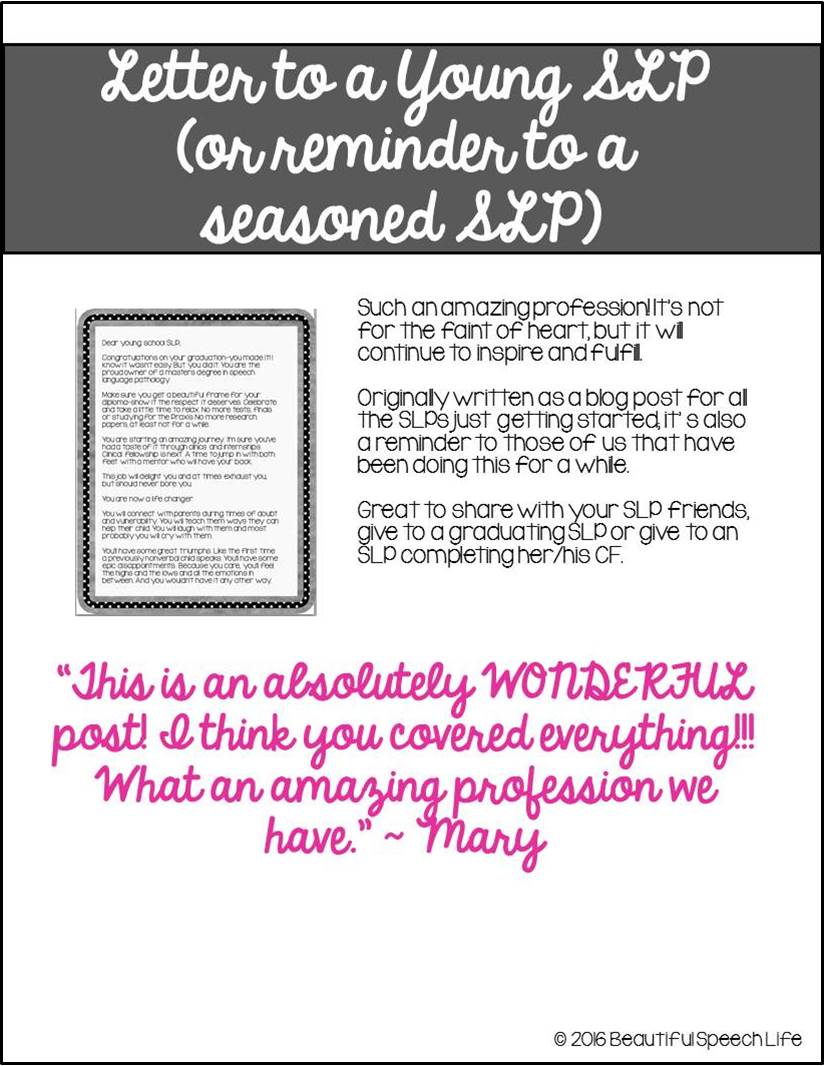
Step 2: Print Listening Posters: Print and laminate these posters. Place them where your students can see them from your therapy table. Explain them. For example: “This is what we need to do to be a good listener. Point to each picture, read caption and demonstrate. After you go through all the posters, have students say them with you as you point. (eg.”Eyes looking, ears listening, etc.”)[spacer height=”10px” id=”2″]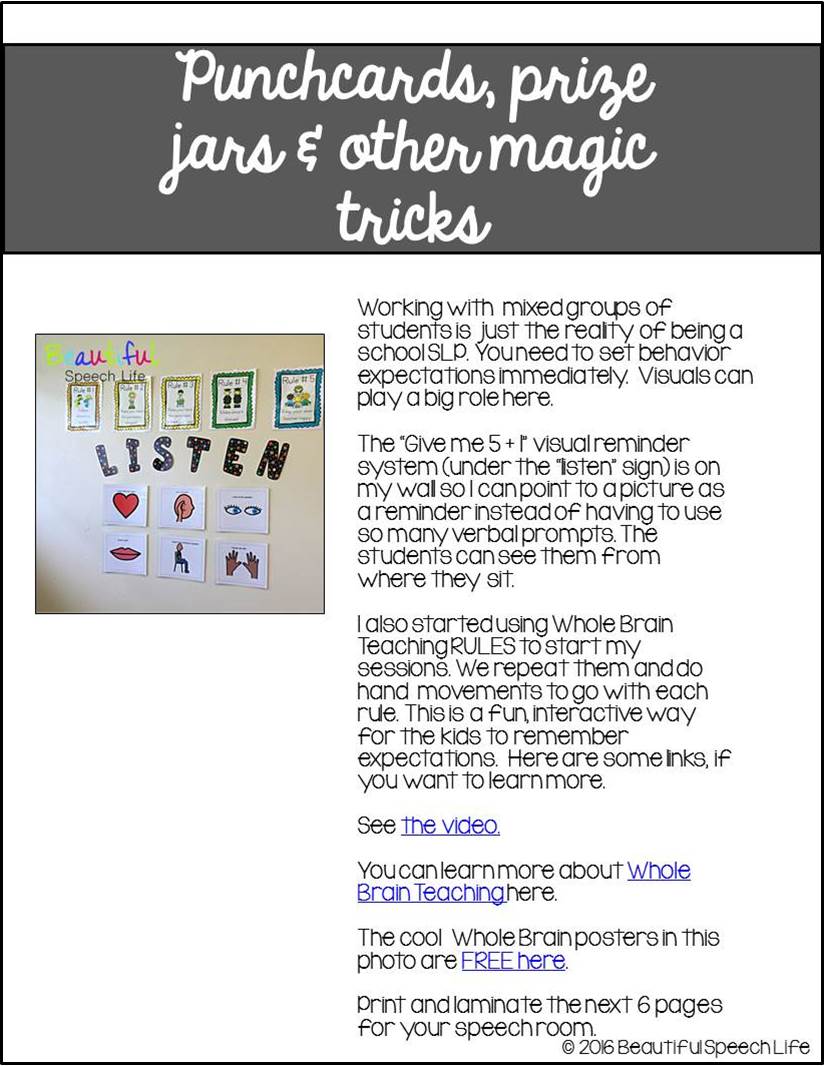
Step 3: Go to the FREE Whole Brain link on page 9. Print and laminate the Whole Brain Posters. Click on the video link to see an example of how they are used. I use these to start every session for my K-4 students. I still use it with my junior high functional skills class, we just do the movements in a more “adult-like” manner.[spacer height=”10px” id=”2″]
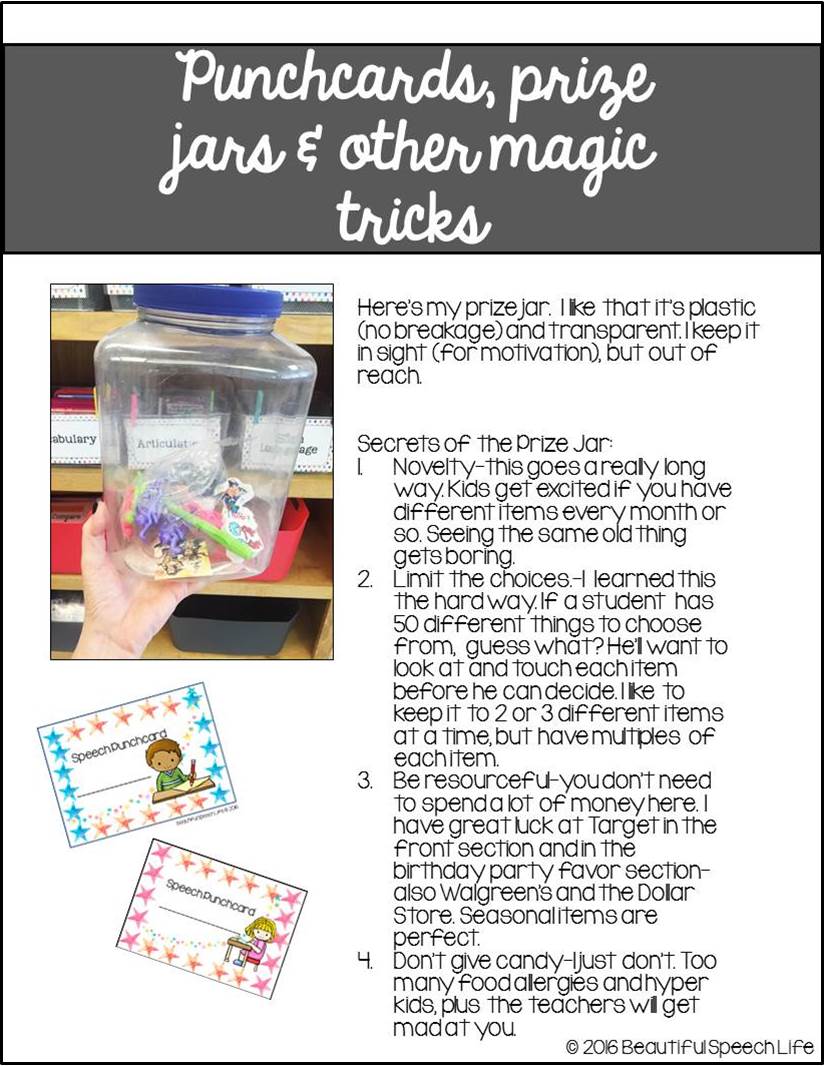
Step 4: Choose the Speech Punchcards you like and print them. Now, I use the color version because kids love colorful things. I also include a black and white version because of Murphy’s Law-color copiers are most likely to break, jam, or run low on ink when you just have 5 minutes to print something. These are such easy prep, just two cuts per page and you are ready to go. [spacer height=”10px” id=”2″]
Step 5: Get yourself a prize jar or box. Make a trip to Target and/or the Dollar Store for some cheap, fun prizes. Read my tips for how to keep it interesting on page 17.[spacer height=”10px” id=”2″]
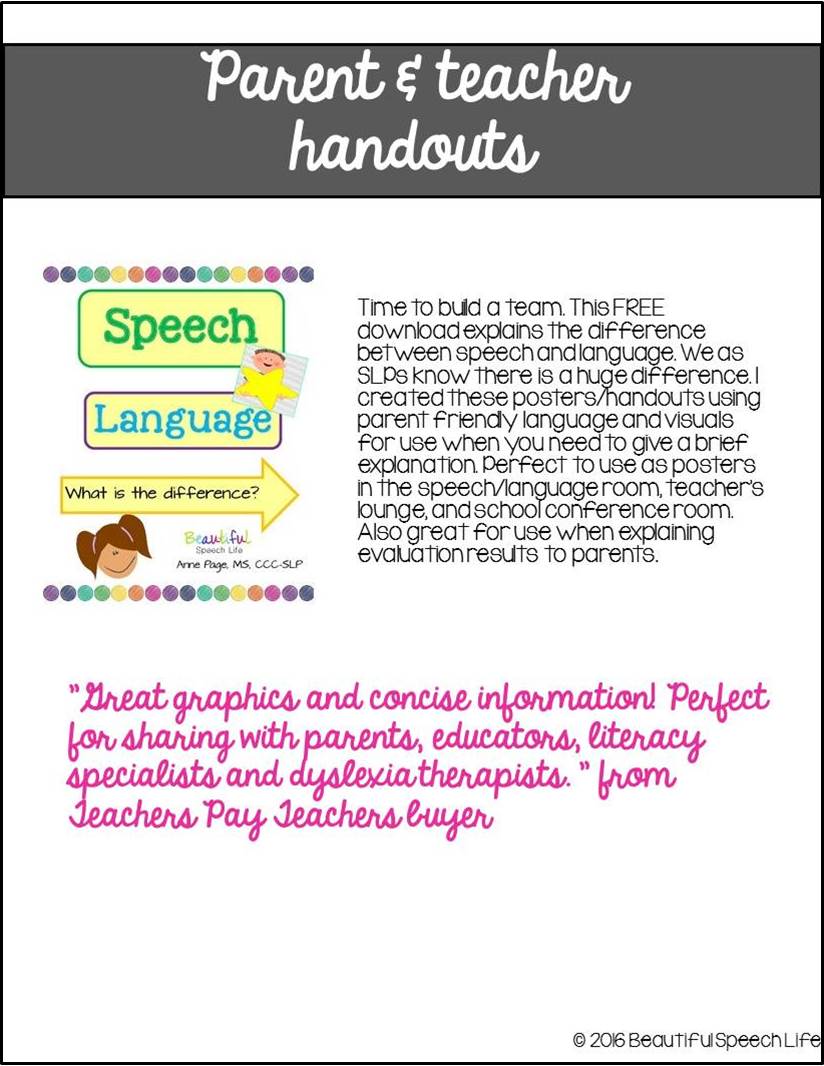
Step 6: Print the “Speech Language, What is the Difference?” posters. Decide where you want to put them. Some ideas are: speech room bulletin board, staff room, and conference room. They are also handy for parent teacher conferences, staff development days and evaluation meetings.[spacer height=”10px” id=”2″]

Step 7: Look through the parent teacher handout section. Choose some of the “What’s Speech got to do with Academics?” handouts to have on hand for IEP and eligibility meetings. These can be used as posters too. Bonus: I included on to use in May 2017 for Better Hearing and Speech Month. See?! Look how on top of the game you are already.[spacer height=”10px” id=”2″]

Step 8: Choose the Student Snapshots you like best. Print one for each student on your caseload, plus some extras to fill out as IEPs are reviewed and revised. (I just keep the extras in a file folder) Follow the instructions on page 32.[spacer height=”10px” id=”2″]

Step 9: Read through “But What Does it Mean? 10 Tips for Explaining Speech and Language Evaluations in Parent Friendly Language”. This is important stuff that will help you to make that all important connection with parents (a big part of being an SLP Boss). If you’re a paper person print it out.[spacer height=”10px” id=”2″]

Step 10: Print 3 copies of the Parent Communication Log sheet of your choice. Use this all year. See instructions on page 51.[spacer height=”10px” id=”2″]

Step 11: Print and laminate testing sign.
Step 12: Print and frame (or laminate) you’re favorite SLP Like a Boss Poster. It’s my little present to you, a reminder that you’ve got this.[spacer height=”10px” id=”2″]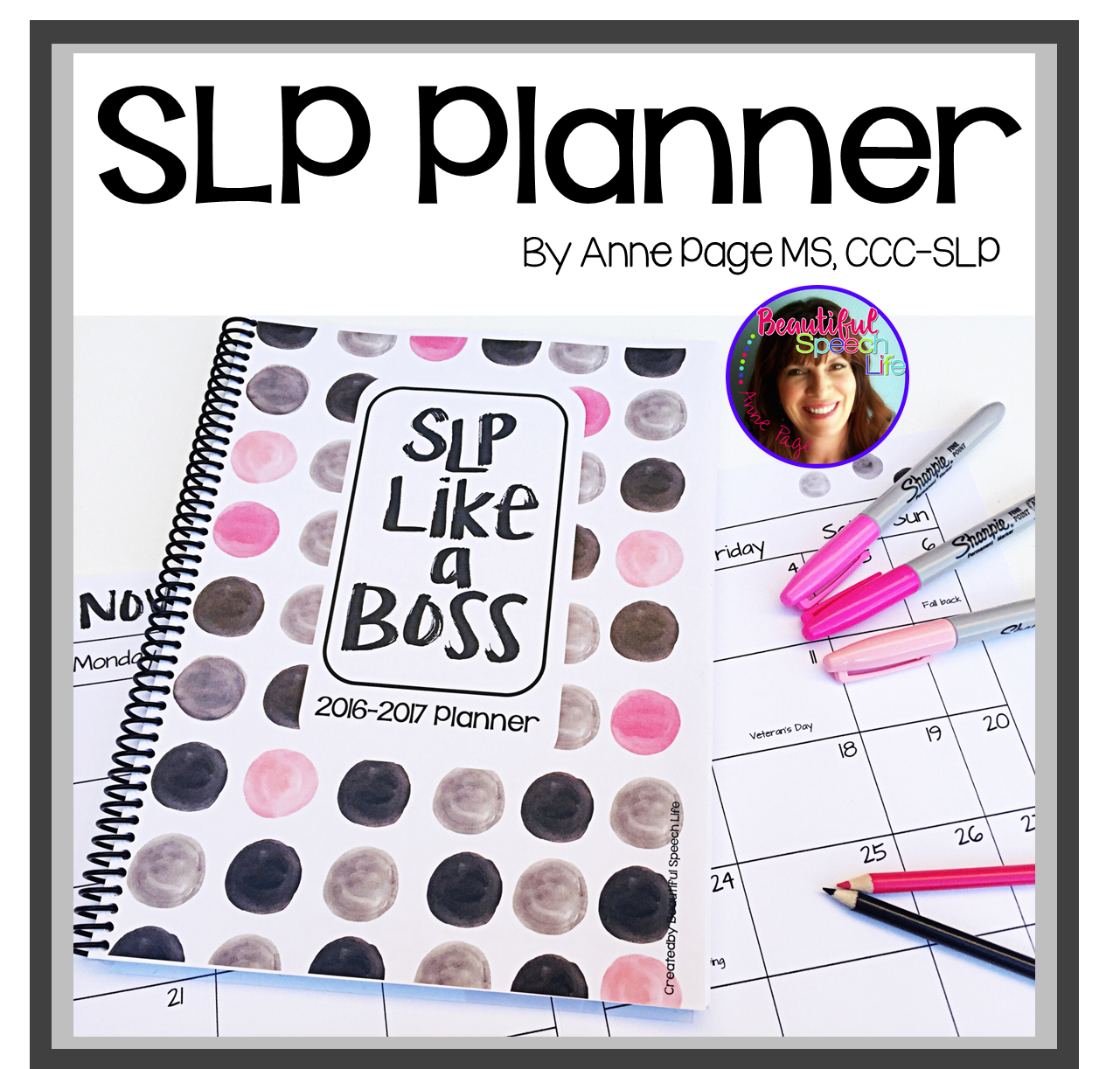
Step 13: Click this link if you need an SLP Planner. This planner is by my side all day. At the affordable price of $5.00, it is chock full of resources. The front cover is the only color page; the rest of the pages are black and white. You provide the color, because doodle borders and coloring pages are included. Yes, it’s true, I do love to color-that might be why I included these fun pages.[spacer height=”10px” id=”2″]
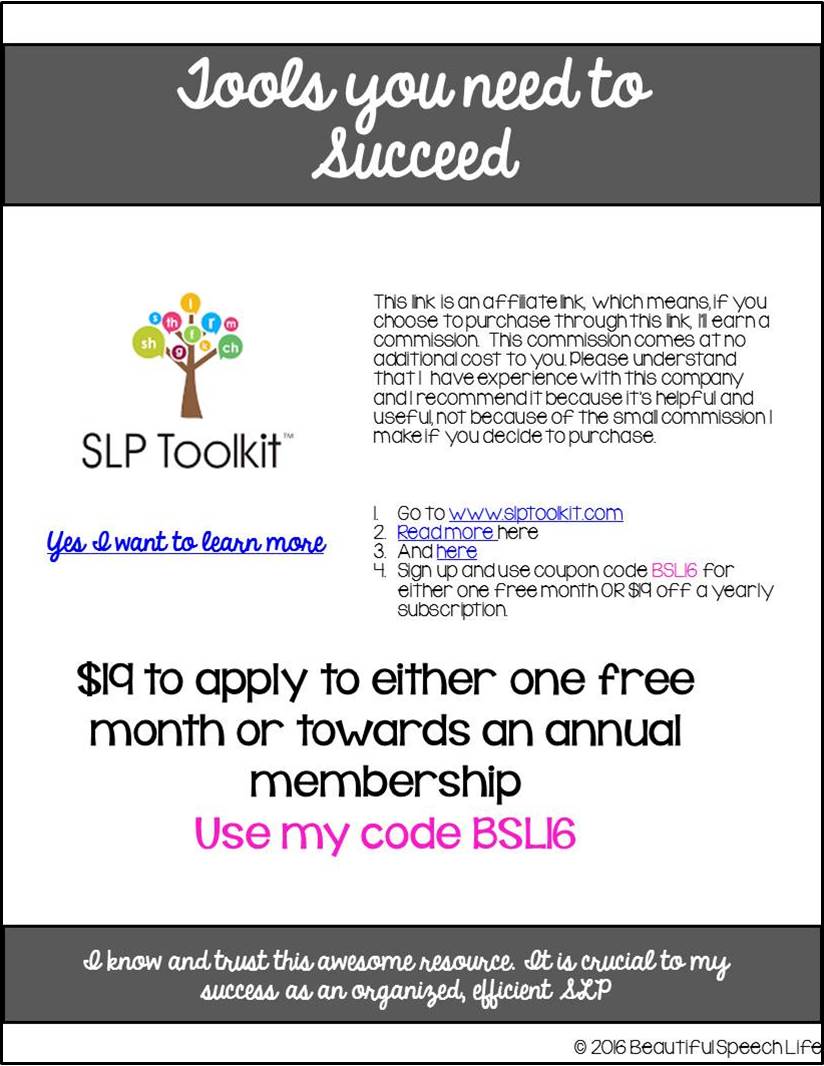
Step 14: This step can be a game changer. If you are really ready to up your game, have I got a tool for you. It is one of the most used tools in my bag of tricks! SLP Toolkit has saved me HOURS of work. Now I can easily assess present levels and give accurate, helpful progress reports. And the goal bank to-die-for! Go to pages 60 and 61 to read more about it. You can also click here and here to read the articles I wrote about SLP Toolkit.[spacer height=”10px” id=”2″]
So there you have it! Everything you need to feel more joy and less stress as you get your school year off to a brilliant start.[spacer height=”10px” id=”2″]
Click here to get your FREE copy.

ALL my best,


by Anne Page | Mar 22, 2016 | SLP Time Hacks, The Organized SLP

SLPTimeHacks
Last Spring at this time, I was REALLY frantically busy. So…I didn’t do my Medicaid billing until May. That’s three months worth; it took me two solid days of desk work, gave me sore neck and had me singing the blues! I would much rather have been spending time with my students. I knew there had to be a better way.[spacer height=”20px” id=”2″]
Do you have to do Medicaid billing?[spacer height=”20px” id=”2″]
Do you dread doing it and save it till the end of the month? Or even worse save it till the end of two months?[spacer height=”20px” id=”2″]
In my district we do Medicaid billing. So that means in addition to gathering data, we need to submit that information through a third party billing company. It can be tedious and feel redundant but that’s how the school funds part of our services.[spacer height=”20px” id=”2″]
What I’ve done in the past (after my 3 month nightmare) is at the end of the month, panic, gather my notes and data and then spend a full day billing. [spacer height=”20px” id=”2″]
A whole day…no! Not gonna happen anymore.[spacer height=”20px” id=”2″]
So in January I tried a little experiment. Instead of saving up my Medicaid billing, I decided to bill immediately after a group when possible. If I have several back-to-back sessions, then bill at the end of the day.[spacer height=”20px” id=”2″]
I kept track of the time spent billing, which averages out to about 30 minutes a day. I made sure I scheduled that time for the rest of the month. [spacer height=”20px” id=”2″]
I noticed that once I got into the habit of billing daily, it was pretty doable.[spacer height=”20px” id=”2″]
I loved myself on that last working day of January. All I had to do was hit the “confirm all” button.[spacer height=”20px” id=”2″]
As a result, I have done this for February and March. Never gonna look back.[spacer height=”20px” id=”2″]
There is truth and value in “a stitch in time saves nine” and even in “how do you eat an elephant?” (one bite at a time, okay but I still think that’s gross).[spacer height=”20px” id=”2″]
One other thing I did that has been a huge time-saver/blues reducer is I spent some time really getting to know the system. I learned several shortcuts about the calendar feature and the group notes feature. I also identified exactly what information was needed by Medicaid in our state. Combined, these shaved off several more minutes daily.[spacer height=”20px” id=”2″]
I know it’s frustrating to juggle so many demands. But by planning ahead to bill daily and taking time to fully learn your billing company’s system, you’ll be amazed at how much more manageable this chore can be.[spacer height=”20px” id=”2″]
Keep coming back to read about my continuous search to help you find ways to streamline and save time, so that you can stress less and spend time doing what really brings you fulfillment.[spacer height=”20px” id=”2″]
Did you like this post? If you did please sign up below to be on the email list so you’ll be the first to know about more time saving tips and fun, engaging therapy materials.[spacer height=”20px” id=”2″]
For more time saving ideas read these posts:
SLP Time Hack: SLP Toolkit, Dream or Reality
SLP Time Hack: SLP Toolkit How to Stop Dreading Progress Reports
SLP Time Hack: Work Life Balance 7 Strategies
Keep doing what you do, you are making the world a better place,


by Anne Page | Mar 15, 2016 | Reviews, SLP Time Hacks, Technology, The Organized SLP
 [spacer height=”20px” id=”2″]
[spacer height=”20px” id=”2″]
Last week in” SLP Time Hacks: Streamlining Progress Reports Dream or Reality?”, I talked about SLP Toolkit, a web based software program that was created by two speech language pathologists. Lisa Kathman and Sarah Bevier. In case you missed it,
click here. [spacer height=”20px” id=”2″]
You can use SLP Toolkit to screen, baseline test, progress monitor, and write goals for students. Last week I tested it out specifically for progress monitoring. I have to tell you, I love it![spacer height=”20px” id=”2″]
First I set up my caseload, which was really easy and didn’t take too long at all. Just input student’s name, IEP date, evaluation date, case manager, teacher and grade. A really helpful feature is the ability to sort by any of the fields. For example, I like to write my progress reports by grade level. I can just click on Grade and oila! my caseload is organized by grade level. This makes my list-building organized SLP heart very happy. [spacer height=”20px” id=”2″]
The progress monitoring feature has a speech sound production area which includes articulation (with all sounds) and a phonological process area. Other areas include subheadings of cognitive, social language, expressive receptive language, fluency, and voice/resonance.[spacer height=”20px” id=”2″]
Within each of these areas there is an extensive list to choose from. For example, I have a student that has a goal to compare and contrast grade level vocabulary. Here’s what I did:
Click expressive/receptive language
Click semantics
Click Compare and Contrast
Click Level 2
A screen comes up with a list of 10 word pairs, I ask student to tell me one way the words are alike and one that they are different.
I click thumbs up or flag.
When finished I click “record data” (which resets for the next time)
I am taken back to the progress monitoring screen where the score is shown.[spacer height=”20px” id=”2″]
The screen is user-friendly with a sidebar for the menu and features are easy to click.[spacer height=”20px” id=”2″]
Although I haven’t used the social language feature yet, it looks really interesting and there are many rubrics. What I like is that the rubrics are “clickable”. You click on the area that fits the student’s current level of competence and the score is placed in the bar at the bottom of the screen. Also the correct description is included with the score ready to be copied and pasted into your progress report. [spacer height=”20px” id=”2″]
The progress monitoring tool is leveled (which is awesome). The stimulus items chosen for each of the different levels were selected considering a combination of research, academic standards, grade band Tier 2 vocabulary, and developmental milestones. So important to me to know that all of these items were taken into consideration. The levels are: Level 0-preschool, Level 1-kindergarten, Level 2-grades one and two, Level 3-grades three through five, Level 4-grades six through eight and Level five-grades nine through 12. [spacer height=”20px” id=”2″]
I’m not going to walk you through this step-by-step because SLP Toolkit has several tutorials that do a great job of that. I’ll put a link at the end of this post for you.[spacer height=”20px” id=”2″]
I do want to highlight what I like most about using SLP Toolkit for my progress reports.[spacer height=”20px” id=”2″]
1. It’s really easy. No shuffling papers and digging for data sheets. Everything I need is on my computer screen. (And it syncs across devices, so I can use my iPad too).[spacer height=”20px” id=”2″]
2. It’s user-friendly and easy to navigate.[spacer height=”20px” id=”2″]
3. I’m using new materials that the student isn’t used to, so I can see if the skill is carrying over across different materials and situations.[spacer height=”20px” id=”2″]
4. I like that I can click on the student’s name, see the goals at a glance, select the progress monitoring tool I want and then go. It’s very time efficient. Depending on the number of goals a student has, the whole process is quick. I’d say 15-20 minutes per student.[spacer height=”20px” id=”2″]
5. As I said earlier, I am really happy with the fact that it is leveled and that the leveling is based on research and standards.[spacer height=”20px” id=”2″]
6. It’s affordable. $19 a month (or $180 annually) to not only keep myself organized and efficiently monitor progress but to write goals, keep a goal bank and baseline test is a bargain.[spacer height=”20px” id=”2″]
7. When it is time to do the next round of progress reports, I will be able to compare them side by side with the progress monitoring I just completed to view progress across time. I love that feature.[spacer height=”20px” id=”2″]
The whole process was so smooth and stress free for me compared to my old way of doing things. I really am kind of looking forward to doing my progress reports next time, so I can compare them to the ones I just did. I’m also looking forward to having a goal bank at my fingertips and to using the present level assessments.[spacer height=”20px” id=”2″]
My recommendation to you is to check it out.
Click on this link where you can get a free trial for up to five students. Do a little test drive, look at all the awesome features. I really think you will be as impressed as I am. [spacer height=”20px” id=”2″]
Disclaimer: I did receive a no-cost six month subscription of SLP Toolkit, so I could review it and give feedback. All of the opinions expressed are strictly my own.[spacer height=”20px” id=”2″]
Did you like this post? If you did please let me know in the comments below. Make sure to join my email list for more posts like this and for a monthly free therapy product.[spacer height=”20px” id=”2″]
No more dreading progress reports!
P.S. Here is a link to the progress monitoring
tutorial.

by Anne Page | Mar 6, 2016 | Reviews, SLP Time Hacks, Technology, The Organized SLP, Uncategorized

Progress. Reports. Two words that strike the heart of every school SLP with dread and trepidation. They’re tedious and many times we feel like we don’t have enough information to give a clear picture of each student’s communication skills. We end up shuffling post-its and digging for data sheets. No wonder we procrastinate doing them. [spacer height=”20px” id=”2″]
Have you ever asked yourself why doesn’t someone create an accurate, effective way to report progress? [spacer height=”20px” id=”2″]
Guess what? Somebody has. [spacer height=”20px” id=”2″]
Sarah Bevier MS, CCC-SLP and Lisa Kathman MS, CCC-SLP are two school-based SLPs that had a great idea and did something about it. They are passionate about streamlining SLP workloads so we can spend our time where it counts – with our students.The result is
SLP Toolkit, a web-based software program that might just be exactly what you and I have been looking for.

When Sarah and Lisa invited me to test SLP toolkit with a six-month subscription, I have to admit I was thrilled. When I realized we live in the same city, I knew we had to meet in person. We agreed on a time and place for lunch. Even though it was kind of like a blind date, we immediately recognized each other from Instagram, Facebook and Twitter. [spacer height=”20px” id=”2″]
Sarah and Lisa are both lovely. So easy to talk to, they are extremely knowledgeable, professional and forward thinking. Last Saturday, sitting on a sunny patio, over salads and bruschetta we talked about how SLP Toolkit came to be.[spacer height=”20px” id=”2″]
Let’s back up to three years ago, Lisa and Sarah, both Arizona State University (ASU ) graduates, were working in the Mesa Public Schools program. They bonded over EET, (The Expanding Expression Tool) talking about how well it was packaged and how it fills a need. While meeting on weekends in Sarah’s craft room to create therapy products, talk soon turned to progress monitoring tools. The original idea was based on collecting data efficiently and accurately. Sarah says it grew from all the things they wished they had when they were starting their school SLP careers.[spacer height=”20px” id=”2″]
Lisa tells how they spent the next three years tirelessly researching vocabulary selection and standards as well as careful consideration of developmental milestones. The resulting SLP Toolkit is a comprehensive, leveled progress monitoring tool covering the areas of cognition, speech sound production, expressive/receptive language, voice/resonance, fluency and social language.[spacer height=”20px” id=”2″]
Fast forward to January 15, 2016… SLP Toolkit is launched. I asked Sarah and Lisa how they felt on the big day, here is their collective reply..[spacer height=”20px” id=”2″]
“Excited, anxious, overwhelmed, relieved, amazed, afraid, elated and proud. We had poured everything into this…and it has been an emotional journey. Prior to starting we had printed out several quotes to remind us to never to let doubt get in our way. Our favorite was ‘It always seems impossible until it’s done’, yet we were still shocked that we had actually done it. It’s a terrifying experience but we genuinely believe in SLP Toolkit and the positive impact it can have for SLPs. We would do it all over again.”[spacer height=”20px” id=”2″]
“What would you say to a new or seasoned SLP who’s thinking about getting SLP Toolkit?” I asked. “You’re welcome” Sarah humorously replied with a laugh. “We did all this work for you. Go on there, explore, use it. There’s no limit to the free trial. You have access to all the tools for up to five students to get a good picture of how it works.”[spacer height=”20px” id=”2″]
Lisa added “It’s about less paper, less anxiety…we created this for you, we are just sharing it.”[spacer height=”20px” id=”2″]
Are you intrigued? I know I am.[spacer height=”20px” id=”2″]
The amount of research, knowledge and love that have gone into the creation of SLP Toolkit is impressive. I have thoroughly enjoyed getting to know Lisa and Sarah; I love our SLP community. [spacer height=”20px” id=”2″]
So here’s what’s next…
Click on this link to see for yourself what
SLP Toolkit is all about. This is where you can get your free trial for up to five students, kind of like driving a car before you buy it. . A full subscription is $19 a month or $180 annually. [spacer height=”20px” id=”2″]
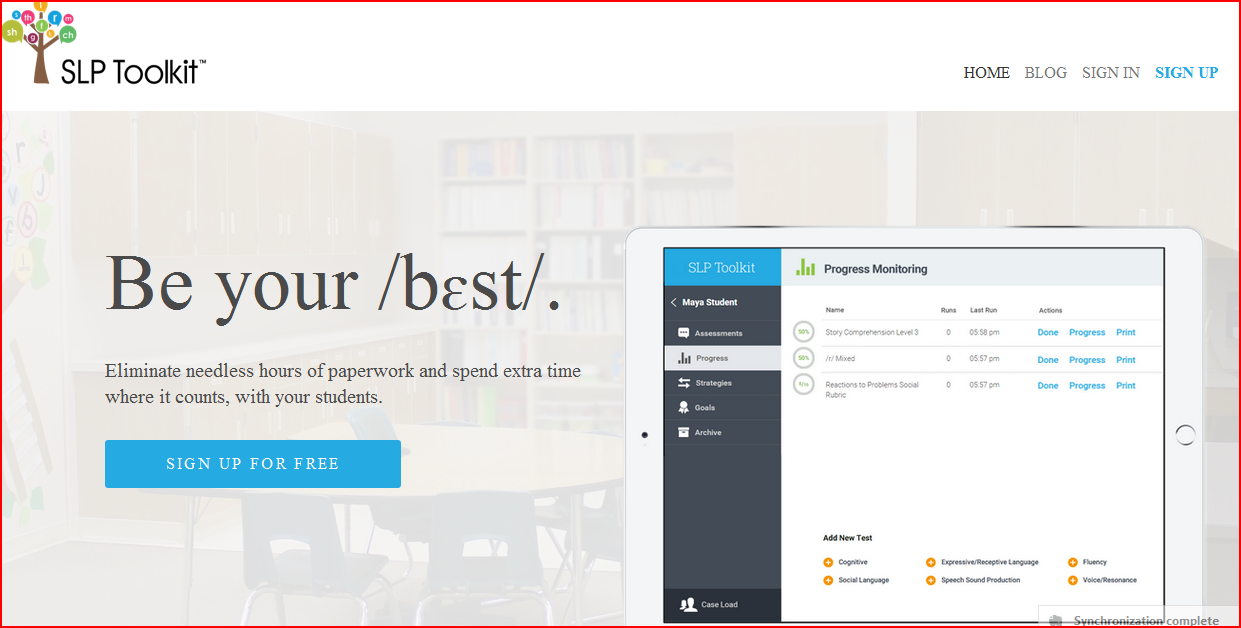
The
SLP Toolkit blog is also full of information and video tutorials, so go look into that as well.You’re going to be excited when you see what it can do. So far, I have created my caseload and used the goal bank, (which is so user-friendly). But I’ll talk more about that next week.[spacer height=”20px” id=”2″]
In the second part of this series, I’ll report back to you all about my experience using SLP Toolkit to do this quarter’s progress reports. I’ll also be posting little videos on Twitter, Facebook and
Instagram so make sure to follow me by clicking on the links.[spacer height=”20px” id=”2″]
Did you like this post? Make sure to join my email list for more posts like this and for a monthly free therapy product. [spacer height=”20px” id=”2″]
Can’t wait to report back to you!
P.S. (Disclaimer: While Lisa and Sarah gave me a six month subscription at no cost, all of the opinions here are strictly my own).
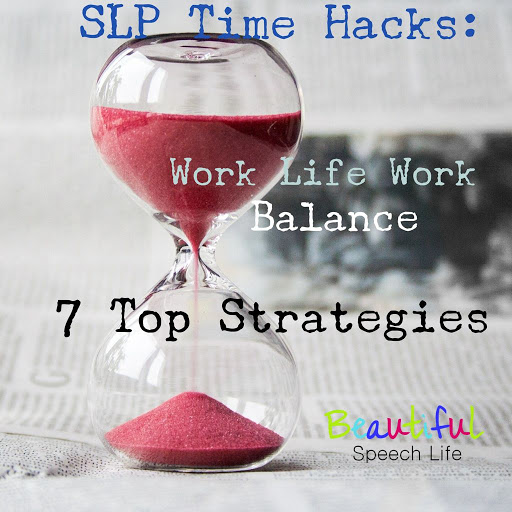
by Anne Page | Jan 26, 2016 | Blog, Inspiration, SLP Time Hacks
I know a lot of SLP’s that work at their day job, have families and have second jobs as SLP bloggers/TPT sellers. How do we manage big caseloads and endless reports at work and take care of our families and find time to write a blog and create therapy materials? Can I just say I probably have more questions than answers? [spacer height=”default”]
It can be quite a balancing act with no perfect right answers. These are questions each SLP just has to answer for herself.[spacer height=”default”]
What I can do is provide some ideas and battle plans that have worked for others. I can get pretty scattered here so I had to choose my top seven. [spacer height=”default”]
1. Be crystal clear on your priorities.
For me my spiritual foundation comes first, that has to be in place and nurtured for me to be able to give to others. Next is my family, spending time with them and letting them know they are loved is everything to me. The rest is a little harder to separate. Health and fitness. Work. Adventure. Friends. More work. Following my dream. It’s kind of like the Stephen Covey rocks in a jar example: spirituality and family love are the rocks and the rest is the sand.[spacer height=”default”]
2. Perfection is the enemy.
I really battle with perfectionism. I consciously and daily ask myself “Does it need to be perfect or does it need to be done?” Don’t give me wrong, I have high standards, I just choose my battles. My bed probably doesn’t need to be made perfectly every time, so it’s okay if my husband makes it (haha).[spacer height=”default”]
3. Schedule everything
Make your list and then write the items down in your calendar. That is how they get done. There is some kind of magic in taking this action. Schedule little chunks of uninterrupted time to write blog articles and create TPT products. If you’re like me, this time is hard to come by. Guard it from the time-wasters.[spacer height=”default”]
4. Ask for support.
Don’t try to do it all yourself. If you’re working really hard on a deadline, ask your husband to make dinner or get takeout. Hire a housekeeper. I did that last year and it has been one of the nicest things I have ever done for myself. If you are stumped with a problem at work, reach out to your SLP colleagues. There are some really supportive Facebook groups link here and SLP Instagram community is very supportive as well.
Click here to read my post about Facebook groups.[spacer height=”default”]
5. Think outside the box.
Do you always do laundry, groceries and errands on the weekend? What about throwing in one load on Tuesday night when you have an hour to blog? Try online order and delivery. I used Prime Now for the first time this weekend and saved myself three trips and probably an hour of time for a seven dollar delivery fee.[spacer height=”default”]
6. Use social media-don’t let it use you.
Cut back on social media time. Noooooooooo! We SLP’s are social creatures, it’s so easy to just pop over to Facebook to check if someone replied to our post or to see what’s new on a group board. I started limiting my social media time to certain times of day and I give myself a time limit. As a result I feel less scattered and I can concentrate on what I’m doing. I love connecting but now I do it on my own time (turn off notifications, you can do it!)[spacer height=”default”]
7. Take care of yourself!
If you don’t do it no one else will. Save some time just for you. I know this is probably the hardest one but it’s the most important. You have to fill the well. Write it down, negotiate it with your people, beg borrow or steal it, but do it. Give yourself that time to dream, reflect and just be.[spacer height=”default”]
These are my tips gleaned from wise friends, life experience and countless books. Take what resonates for you and leave the rest behind.[spacer height=”default”]
And from the bottom of my heart kudos to all of you for having the desire and determination to push through boundaries and follow your dreams.[spacer height=”default”].
You make the world a much brighter place,
P.S. Did you like this post? If you did sign up for my email list to be the first to know about new products, freebies and sales. Also follow me on TpT to receive exclusive monthly freebies only available to TPT followers.


























 Hey there I’m Anne Page. I help heart centered SLPs and educators put the fun in functional communication.
Hey there I’m Anne Page. I help heart centered SLPs and educators put the fun in functional communication. 